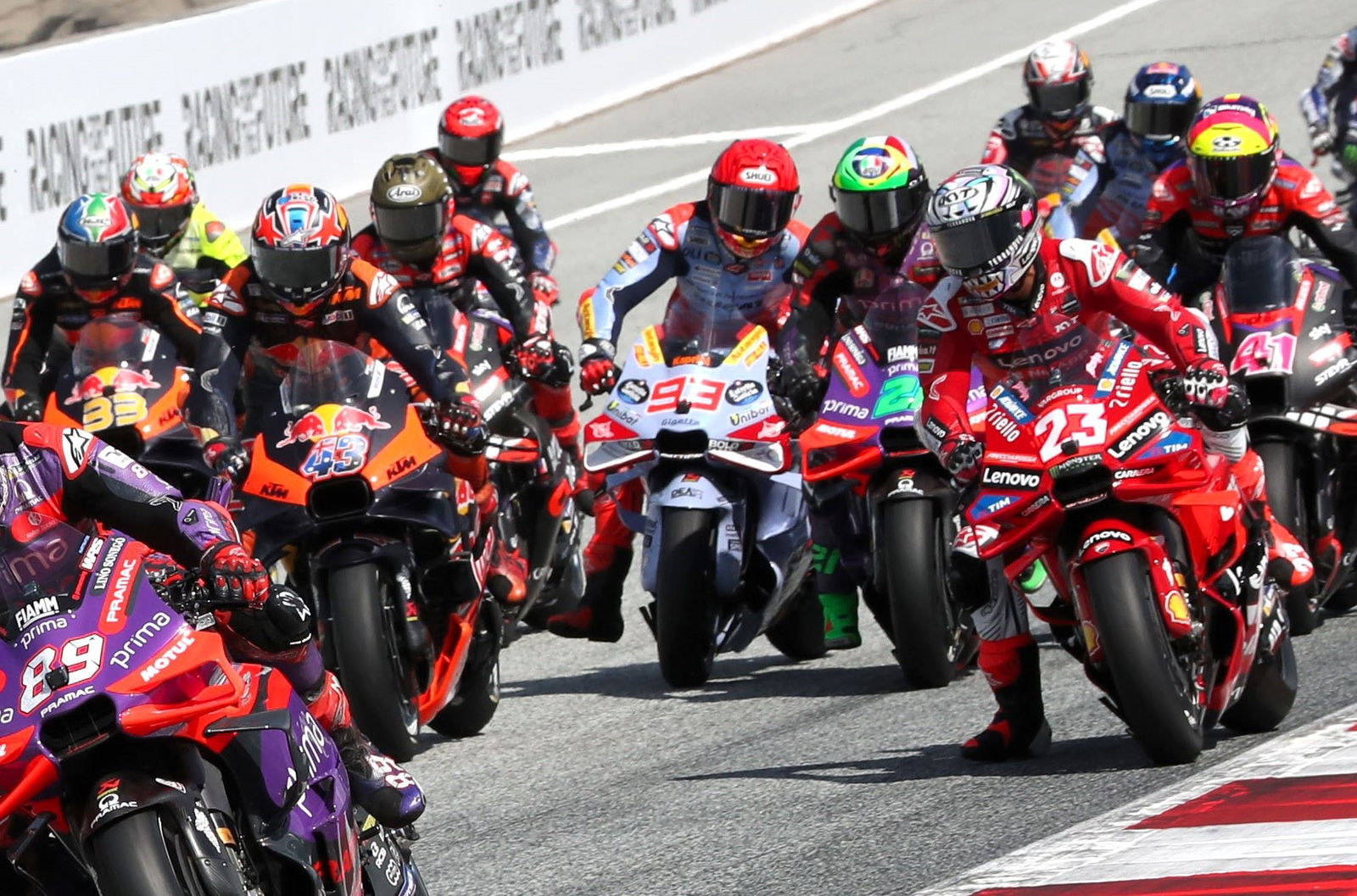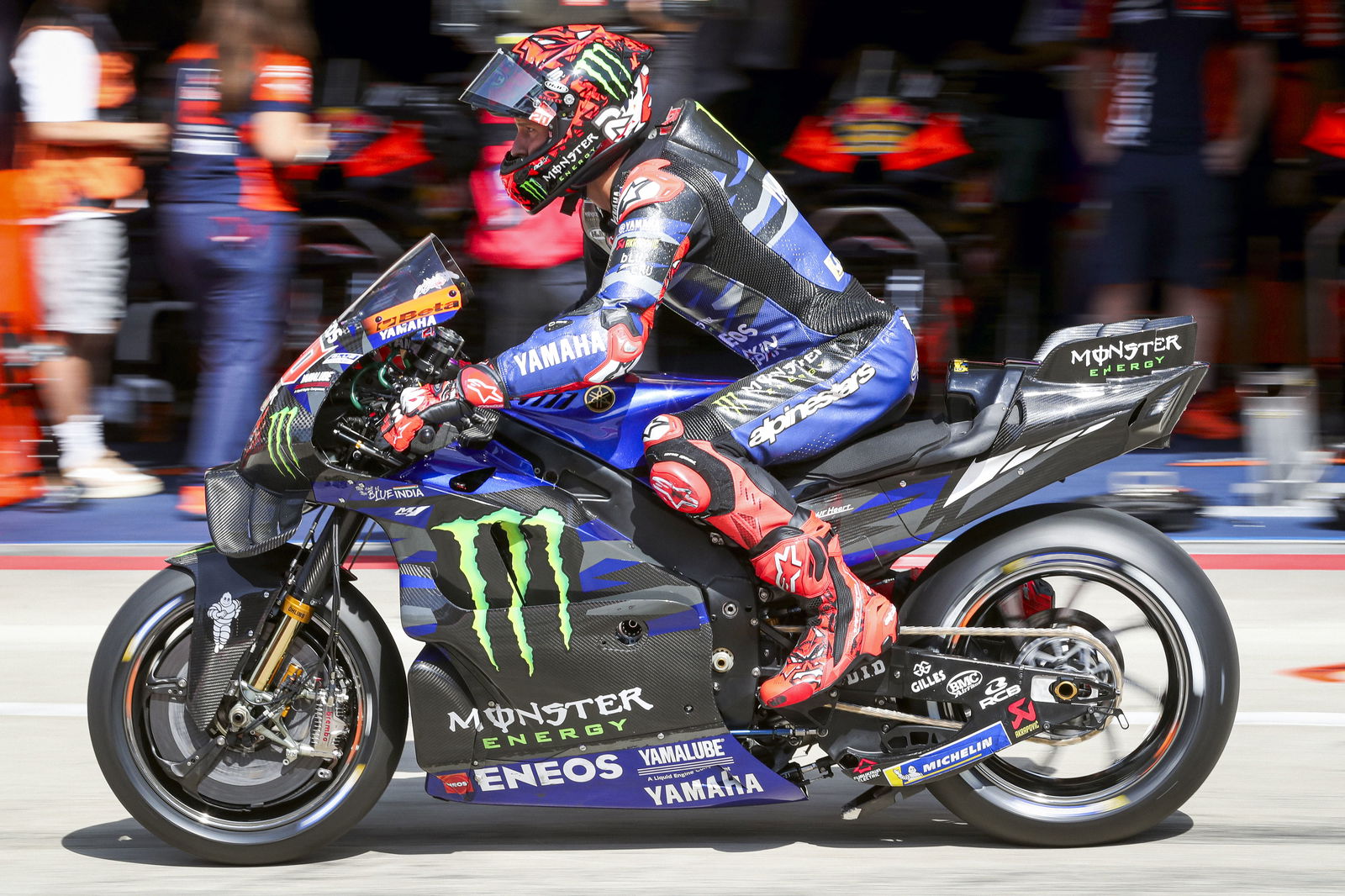Pedro Acosta endures nightmare | Five talking points after Austrian MotoGP
Here are five major talking points from the Red Bull Ring

The Austrian MotoGP was dominated by a rider who has won seven of the 11 main races this year, and seven seconds covering the top three positions. Fortunately, there were rides further back who threw up some intrigue.
From Marc Marquez’s start disaster to Pedro Acosta’s Austrian nightmare, here are our five key points from the Austrian MotoGP.
Bagnaia’s dominance
Francesco Bagnaia’s victory in Austria tied him with Kevin Schwantz on 25 premier class victories. He’s now six behind Dani Pedrosa and Eddie Lawson on the all-time list, and has seven Grand Prix victories this season, already equal with what he achieved in all of 2023.
Since the 2021 Aragon Grand Prix, and including that race which was Bagnaia’s first premier class GP victory, there have been 57 MotoGP races run. Bagnaia’s 25 wins gives him a win rate of 43.9 per cent since he won his first GP, and his 38 podiums in that time mark a 66.7 per cent hit rate for the top three.
He also now has a 63.6 per cent win rate for 2024, and the only Grand Prix he’s finished off the podium since his ninth place in the 2022 Valencia Grand Prix was this year’s Americas GP.
The Italian is, from these statistics, clearly the dominant rider in MotoGP of the past two-and-three-quarter years, and he showed why in Austria.
In the post-race press conference, he spoke about how he pushed in the middle of the race to open a gap, knowing that he would be out of rear grip at the end of the race, but also that Martin would be unable to close the two-second gap he’d built.
Many of Bagnaia’s 44 premier class podiums have been achieved thanks to his exceptional understanding of the Michelin tyres, especially the rear. He understands not only how best to conserve grip, but also the optimal moments to use it.
Beating him to the 2024 title is a formidable task for his rivals.
Martin’s urgency
While Francesco Bagnaia was off winning his seventh Grand Prix of the season, Jorge Martin once again had to settle for second.
It’s becoming an odd theme for Martin, as MotoGP’s Sprint format means he’s finished second in each of his last four starts: British Sprint, British Grand Prix, Austrian Sprint, Austrian Grand Prix.
Each of those second places have come in the wake of a victorious factory Ducati, which he must find delightful, especially when it’s his main title rival, Bagnaia, doing the winning in Austria.
While Martin’s last victory was the German Sprint, which feels longer ago than it really was thanks to the summer break and his crash from the lead the day after, he hasn’t won a Grand Prix since the French MotoGP in May. Since then, Bagnaia has won five times, and Martin finished second to him on four of those occasions, Germany being the only exception.
As a result, you cannot in any way question Martin’s consistency this year. Yes, he’s crashed from the lead in two Grands Prix this season, and out of the Italian Sprint, but when he’s finished he’s almost exclusively been on the podium, whether on a Saturday or a Sunday.
Considering that, last year, his title challenge was mostly affected by the kind of result he had in Austria, a seventh, or Australia, a fifth, this podium hit rate is extremely positive for Martin, who remains only five points out of the championship lead.
However, Martin needs to get back to winning again. It’s all good finishing second every week but that won’t win you a title if it’s the same guy beating you every week — especially if that guy has the points lead.
Marquez’s start
Marc Marquez explained how his mistake disengaged the start device on the grid 🗣️ A costly error from the eight time World Champion.#MotoGP #AustrianGP pic.twitter.com/dZCeWdPaMW
— Crash MotoGP (@crash_motogp) August 19, 2024
The most dramatic moment of the Austrian Grand Prix was the start, which is not uncommon but this time it was specifically thanks to Marc Marquez.
He didn’t do anything hugely wrong, but his race was ruined before he even pulled into his grid slot as he hadn’t got his start device engaged.
To engage the front start device, the riders have to brake extremely hard to get it to lock the front suspension down, and then release the brake smoothly to avoid it disengaging as they come off the brake. Francesco Bagnaia explained in the post-race press conference that it’s more complicated to achieve that in Austria because the front forks are set so stiff to cope with the hard-braking demands of the Red Bull Ring.
This is effectively what destroyed Marquez’s race. He had a new tyre fitted before the warm-up lap because a tyre valve was broken on the grid. The new tyre wasn’t heated to the same level as his first tyre, and so he had to work harder on the warm-up lap to put the temperature into the tyre before the start.
After he engaged the front start device while rolling up to the grid, he braked hard again to try to put more heat in the tyre, but this time he released the brake too sharply which disengaged the start device. Without time to re-engage it, his start was ruined, and his hopes of challenging for the podium vanished.
He rode extremely well after that to recover to fourth, and showed pace as strong as the leaders once he had clean air from lap 18, but perhaps the key point of Marquez’s start, therefore, is that — in a moment where every rider has a start device — the jeopardy involved in using start devices is more significant than the benefit they provide.
Acosta’s nightmare
Pedro Acosta’s Austrian Grand Prix was going fairly well on Friday morning, as he finished sixth in FP1.
However, he crashed at turn four late on in the session, having lost temperature from his hard-compound front tyre when he crashed at turn 2b a couple of minutes previously. The crash was a fast and violent one, and while Acosta was physically okay after the crash his weekend fell apart after it.
He missed the top 10 in Practice, then failed to get to Q2 from Q1, and raced to an underwhelming 13th on Sunday.
Acosta is one of those riders who arrives in the top class and makes such an impact that, although you know he’s a rookie, you discard — in relation to him — the standards that usually apply to a rookie. Early in the season, Acosta was KTM’s best rider, but on Sunday he finished 15 seconds behind Brad Binder in fifth.
The reality is that Acosta’s Friday crash was the first major off he’s had in MotoGP. He crashed fairly big on the final lap at the Dutch TT at the fast turn seven, but that was still a fairly ordinary crash, in that he lost the front with a cold tyre in the middle of the corner.
In Austria, though, it was a totally unusual crash, as the front folded the instant he touched the brakes. And the speed — over 300kph — was extremely high.
His weekend from there on was a reminder that Acosta, while clearly one of the most exciting riders in MotoGP, remains a rookie for now.
The Enea Bastianini Experience
Nobody could beat Enea Bastianini at Silverstone — he was just so much better at conserving grip in his rear tyre.
In Austria, there was no way for Bastianini to challenge Bagnaia and Martin. They all had front locking, but Bastianini found it more difficult to deal with it in Austria than the other two.
The Silverstone winner was seven seconds behind Bagnaia at the chequered flag on Sunday, compared to being almost six seconds ahead at Silverstone.
The difference between the two, in the context of a championship, is that Bagnaia has been so consistent — as discussed above — since the Spanish Grand Prix, whereas Bastianini is still experiencing a lot of variance.
Sure, he has scored the same on Sundays as Bagnaia since the summer break, but the truth is that Bastianini got a bit lucky in Austria. Overtaking is tough at the Red Bull Ring because of how the layout induces extreme front tyre temperatures and pressures, exaggerated further by following other bikes.
Bastianini started seventh, and could only get to fourth by the end of the race. The chaos created by Marc Marquez’ bad start on Sunday helped Bastianini get up to third by the end of the first lap, and he stayed there to the flag.
But the key point is Bastianini’s third-row qualifying: when Bagnaia and Martin aren’t at their best, they still manage to qualify on the front two rows, which still leaves the race in their hands. Bastianini falls further, and then has more ground to make up in a more ordinary start scenario.
It’s this continued inconsistency that will continue to make it difficult for Bastianini to really insert himself in the title fight which, after Austria, looks again to be between Bagnaia and Martin.


